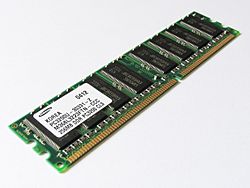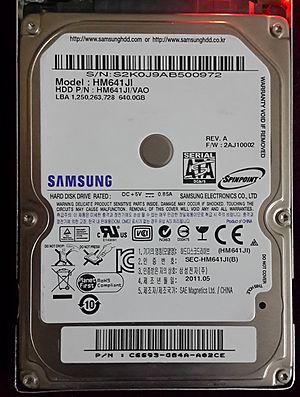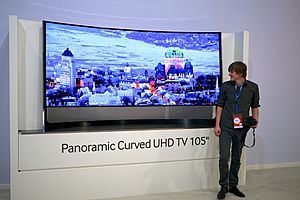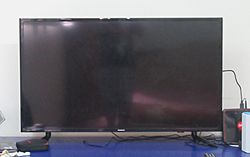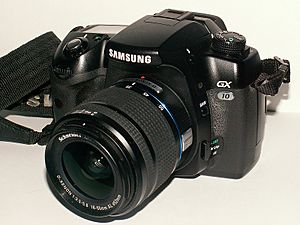Samsung Electronics facts for kids
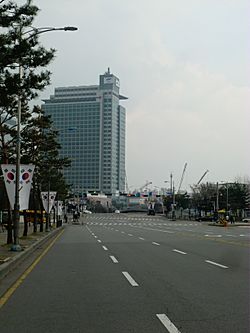
|
|
|
Native name
|
삼성전자 주식회사
|
|---|---|
| Hanja |
三星電子株式會社
|
| Revised Romanization | Samseong Jeonja Jusikhoesa |
|
Formerly
|
Samsung Electric Industries (1969–1988) |
| Public | |
| ISIN | KR7005930003 |
| Industry |
|
| Founded | 13 January 1969 in Suwon, South Korea |
| Headquarters | Samsung Digital City, Samsungno 129, Maetan-dong,
Yeongtong District, Suwon
,
|
|
Area served
|
Worldwide |
|
Key people
|
|
| Products | See products listing |
| Revenue | |
|
Operating income
|
|
| Total assets | |
| Total equity | |
| Owners |
|
|
Number of employees
|
270,372 (December 2023) |
| Parent | Samsung |
| Subsidiaries |
|
Samsung Electronics Co., Ltd. (Hangul: 삼성전자; Hanja: 三星電子; RR: Samseong Jeonja, sometimes shortened to SEC and stylized as SΛMSUNG) is a South Korean multinational major appliance and consumer electronics corporation headquartered in Yeongtong-gu, Suwon, South Korea. It is currently the pinnacle of the Samsung chaebol, accounting for 70% of the group's revenue in 2012. But Lee Jae-yong has stated his intentions to make sure his children do not inherit significant Samsung Electronics positions, which would significantly change the company's inner workings.
Samsung Electronics has played a key role in the group's corporate governance due to cross ownership. Samsung Electronics has assembly plants and sales networks in 74 countries and employs more than 270,000 people. It is majority-owned by foreign investors. As of 2019[update] Samsung Electronics is the world's second-largest technology company by revenue, and its market capitalization stood at US$520.65 billion, the 12th largest in the world.
Samsung has been the world's largest manufacturer of mobile phones and smartphones since 2011, and is best known for its Samsung Galaxy brand. It has developed 5G-capable smartphones, including the Galaxy S23, and foldable phones, including the Galaxy Z Fold 5. The company is a major vendor of tablet computers, particularly its Android-powered Samsung Galaxy Tab collection, and is regarded for developing the phablet market with the Samsung Galaxy Note family of devices. Samsung has also been the world's largest television manufacturer since 2006.
The company is a major manufacturer of electronic components such as lithium-ion batteries, semiconductors, image sensors, camera modules, and displays for clients such as Apple, Sony, HTC, and Nokia. It is also the world's largest semiconductor memory manufacturer and, from 2017 to 2018, had been the largest semiconductor company in the world, briefly dethroning Intel, the decades-long champion.
In 2012, Kwon Oh-hyun was appointed the company's CEO. He announced in October 2017 that he would resign in March 2018, citing an "unprecedented crisis". The company had three CEOs (Ki Nam Kim, Hyun Suk Kim, and Dong-Jin Koh) from March 2018 until December 2021, when the business units were reorganized and they were replaced by Kyung Kye-Hyun and Han Jong-hee. It has also had a separate regional CEO, HC Hong, who led the business in Southwest Asia since 2015 and then moved to Latin America in 2020.
Contents
Logo history
Products
Samsung Electronics produces LCD and LED panels, mobile phones, memory chips, NAND flash, solid-state drives, televisions, digital cinemas screen, and laptops and many more products. The company previously produced hard-drives and printers.
Samsung consistently invests in innovation. In 2021, the World Intellectual Property Organization (WIPO)’s annual World Intellectual Property Indicators report ranked Samsung's number of patent applications published under the PCT System as 2nd in the world, with 3,093 patent applications being published during 2020. This position is up from their previous ranking as 3rd in 2019 with 2,334 applications.
LCD and OLED panels

By 2004 Samsung was the world's-largest manufacturer of OLEDs, with a 40 percent market share worldwide and as of 2018 has a 98% share of the global AMOLED market. The company generated $100.2 million out of the total $475 million revenues in the global OLED market in 2006. As of 2006, it held more than 600 American patents and more than 2,800 international patents, making it the largest owner of AMOLED technology patents.
In 2020, Samsung Display said it was exiting the LCD business.
Mobile and smart phones
Samsung's mobile cell business began with a car phone in 1984, while its first handheld mobile phone called the SH-100 was made in 1988. It expanded to other markets during the 1990s. Its first smartphone was the Samsung SPH-i300 in 2001. During the early 2000s Samsung popularised the clamshell ("flip phone") design, and the SGH-T100 was the first ever "true color" mobile phone and the firm's first to sell over 10 million handsets. In the mid-2000s the SGH-D500 popularised the slider form factor, and later slider products such as the E250 were hits. In 2006 Samsung's X820 with a depth of 6.9 mm was the thinnest phone, and for many years its successor U100 would remain the skinniest at just 5.9 mm. In 2007 it launched the slate style touchscreen phone F700 which would precede its increasingly relevant touch phones such as Tocco and Omnia. Samsung overtook declining Motorola to become the world's second largest mobile phone marker during 2007.
Presently, Samsung's flagship mobile handset line is the Samsung Galaxy S series of smartphones, which many consider a direct competitor of the Apple iPhone. It was initially launched in Singapore, Malaysia and South Korea in June 2010, followed by the United States in July. It sold more than one million units within the first 45 days on sale in the United States.
Semiconductors
Samsung Electronics has been the world's largest memory chip manufacturer since 1993, and the largest semiconductor company since 2017. Samsung Semiconductor division manufactures various semiconductor devices, including semiconductor nodes, MOSFET transistors, integrated circuit chips, and semiconductor memory.
Solid-state drives
In 2016, Samsung also launched to market a 15.36TB SSD with a price tag of US$10,000 using a SAS interface, using a 2.5-inch form factor but with the thickness of 3.5-inch drives. This was the first time a commercially available SSD had more capacity than the largest currently available HDD. In 2018, Samsung introduced to market a 30.72 TB SSD using a SAS interface. Samsung introduced an M.2 NVMe SSD with read speeds of 3500 MB/s and write speeds of 3300 MB/s in the same year. In 2019, Samsung introduced SSDs capable of 8 GB/s sequential read and write speeds and 1.5 million IOPS, capable of moving data from damaged chips to undamaged chips, to allow the SSD to continue working normally, albeit at a lower capacity.
Samsung's consumer SSD lineup currently consists of the 980 PRO, 970 PRO, 970 EVO plus, 970 EVO, 960 PRO, 960 EVO, 950 PRO, 860 QVO, 860 PRO, 860 EVO, 850 PRO, 850 EVO, and the 750 EVO. The SSDs models beginning with a 9 use an NVM Express interface and the rest use a Serial ATA interface. Samsung also produces consumer portable SSDs using a USB-C USB 3.1 Gen 2 connector. The drives offer read speeds of 1,050MB/s and write speeds of 1,000MB/s and are available as 500GB, 1TB and 2TB models.
Like many other SSD producers, Samsung's SSDs use NAND flash memory produced by Samsung Electronics.
Hard-drives
In the area of storage media, in 2009 Samsung achieved a ten percent world market share, driven by the introduction of a new hard disk drive capable of storing 250Gb per 2.5-inch disk. In 2010, the company started marketing the 320Gb-per-disk HDD, the largest in the industry. In addition, it was focusing more on selling external hard disk drives. Following financial losses, the hard disk division was sold to Seagate in 2011 in return for a 9.6% ownership stake in Seagate.
Televisions
In 2009, Samsung sold around 31 million flat-panel televisions, enabling to it to maintain the world's largest market share for a fourth consecutive year.
Samsung launched its first full HD 3D LED television in March 2010. Samsung had showcased the product at the 2010 International Consumer Electronics Show (CES 2010) held in Las Vegas.
Samsung sold more than one million 3D televisions within six months of its launch. This is the figure close to what many market researchers forecast for the year's worldwide 3D television sales (1.23 million units). It also debuted the 3D Home Theater (HT-C6950W) that allows the user to enjoy 3D image and surround sound at the same time. With the launch of 3D Home Theater, Samsung became the first company in the industry to have the full line of 3D offerings, including 3D television, 3D Blu-ray player, 3D content, and 3D glasses.
In 2007, Samsung introduced the "Internet TV", enabling the viewer to receive information from the Internet while at the same time watching conventional television programming. Samsung later developed "Smart LED TV" (now renamed to "Samsung Smart TV"), which additionally supports downloaded smart television apps. In 2008, the company launched the Power Infolink service, followed in 2009 by a whole new Internet@TV. In 2010, it started marketing the 3D television while unveiling the upgraded Internet@TV 2010, which offers free (or for-fee) download of applications from its Samsung Apps Store, in addition to existing services such as news, weather, stock market, YouTube videos, and movies.
Samsung Apps offers for-fee premium services in a few countries including Korea and the United States. The services will be custom-tailored for each region. Samsung plans to offer family-oriented applications such as health care programs and digital picture frames as well as games. Samsung's range of smart TVs include the apps ITV Player and motion controlled games such as Angry Birds. Since 2015, Samsung's proprietary FAST streaming service Samsung TV Plus was pre-installed to the smart TVs.
Monitors
The company started as a budget display monitor brand in the 1980s, producing cathode ray tube (CRT) monitors for computers, from which it then evolved. By the end of the decade, Samsung had become the world's largest monitor manufacturer, selling over 8 million monitors by 1989.
During the 1990s to the 2000s, Samsung started producing LCD monitors using TFT technology to which it still emphasizes on the budget market against the competition while at the same time starting to also focus on catering to the middle and upper markets through partnership with brands such as NEC and Sony via a joint venture. As it grew and became more advanced, it later on acquired the joint venture corporations to form the current Samsung OLED and S-LCD Corporation respectively from its former joint venture partners.
Tizen
As of 2015, Samsung smart televisions and smart monitors run an operating system customized from the open-source Linux-based Tizen OS. Given Samsung's high market share in the smart television market, approximately 20% of smart televisions sold worldwide in 2018 run Tizen.
In 2019, Samsung announced that they will be bringing the Apple TV app (formally iTunes Movies and TV Shows app) and AirPlay 2 support to its 2019 and 2018 smart TVs (via firmware update).
Odyssey
Samsung's Odyssey Gaming Monitors are designed for professional gamers and gaming enthusiasts. As of 2022, the Odyssey range consists of 4 main series, each with different resolutions, refresh rate and aspect ratio.
In 2022, Samsung launched the Odyssey Ark, the World's First 55-inch 1000R curved gaming screen. This monitor has 4K resolution with 165 Hz refresh rate and 1ms response time.
Printers
In the past, Samsung produced printers for both consumers and business use, including mono-laser printers, color laser printers, multifunction printers, and enterprise-use high-speed digital multi-function printer models. They exited the printer business and sold their printer division to HP in Fall 2017. In 2010, the company introduced the world's smallest mono-laser printer ML-1660 and color laser multifunction printer CLX-3185.
Speakers
In 2017, Samsung acquired Harman International. Harman makes earbuds under many brand names such as AKG, AMX, Becker, Crown, Harman Kardon, Infinity, JBL, Lexicon, dbx, DigiTech, Mark Levinson, Martin, Revel, Soundcraft, Studer, Arcam, Bang & Olufsen and BSS Audio.
Cameras
Samsung has introduced several models of digital cameras and camcorders including the WB550 camera, the ST550 dual-LCD-mounted camera, and the HMX-H106 (64GB SSD-mounted full HD camcorder). In 2014, the company took the second place in the mirrorless camera segment. Since then, the company has focused more on higher-priced items. In 2010, the company launched the NX10, the next-generation interchangeable lens camera.
Other
Samsung entered the MP3 player (digital audio player, DAP) market in 1999 with its Yepp line. In the initial years the company struggled to gain a foothold because of emerging Korean startups iRiver, Cowon and Mpio. However by 2006, it had gained a significant share in the domestic market as well as Russia and parts of the Middle East, South East Asia and Europe. It was also starting to increase penetration in the U.S. (albeit significantly lower than the market leader, Apple). Samsung launched the world's-smallest DivX MP3 player, the R1, in 2009.
In 2014, the company announced that it was exiting the laptop market in Europe.
In 2015, Samsung announced a proposal for a constellation of 4600 satellites orbiting Earth at 1,400 kilometers (900 mi) altitude that could bring 200 gigabytes per month of internet data to "each of the world's 5 billion people". The proposal has not yet advanced to full development. If built, such a constellation would compete with previously-announced satellite constellations currently under development by OneWeb and SpaceX.
On 13 July 2017, an LED screen for digital cinema developed by Samsung Electronics with GDC Technology Limited was publicly demonstrated on one screen at Lotte Cinema World Tower in Seoul.
See also



